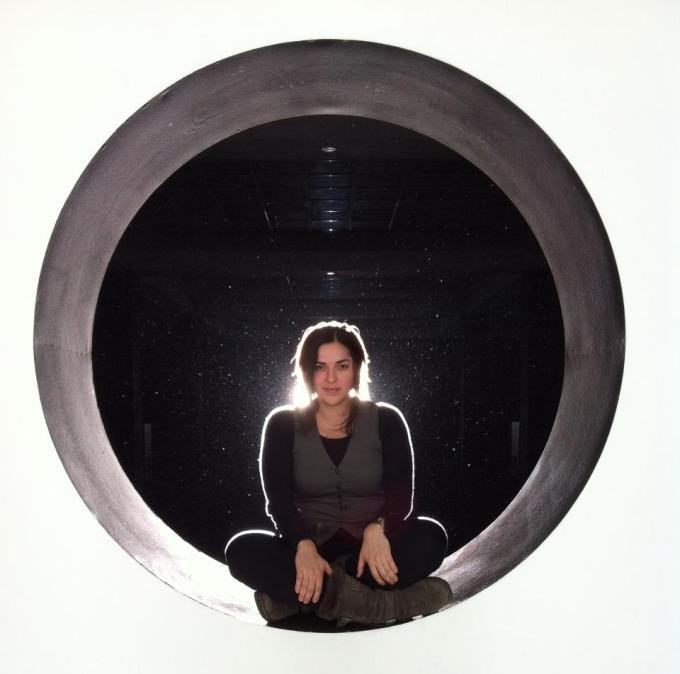
All great art institutions were once startups too.
I was wandering around the U.S.’s largest art museum, New York’s Metropolitan Museum of Art, the other week (on one of those #museumhack walks) when I learned that the institution’s very first acquisition in 1870 was a lowly unused and unfinished Roman sarcophagus dug up from what is now modern Southern Turkey.
Basically, the Met started in the 1860s because a couple of lawyer, banker and publisher dudes visited Paris, stood in envy of the Louvre and decided to build an American answer to Europe’s finest art collections. One hundred and forty years later, the museum spans more than 2.4 million feet with an encyclopedic collection of more 2 million works of art, from antiquity to 20th Century American paintings.
So when I hear newcomers to San Francisco complain that the city’s art scene is too provincial, or the city lacks the sort of creative diversity that other cities have, or that it’s all tech, or too much tech, I get frustrated.
Because as we all know, tech or art or fashion ecosystems don’t just miraculously appear overnight.
They happen because people make them happen.
Josette Melchor is one of those people. She’s been the one woman force behind the creation of San Francisco’s Gray Area (also known as GAFFTA), a non-profit that has validated an emerging form of art called creative coding over the past decade.
Creative coding is about programming expressive, rather than functional, work. It runs the gamut from data visualization, like this very early Gray Area-supported project from Stamen Design that made interactive maps of Tenderloin data on crime and cabs, to projection mapping, like this pretty astonishing video from Bot & Dolly in Potrero Hill. Gray Area has also pioneered urban prototyping, a movement to get city residents involved in trialling new ideas for city life through quick, inexpensive and temporary projects. The “parklet,” first popularized in San Francisco, is a prime example.
While there are emerging institutions at the intersection of art and technology like New York’s Eyebeam and Rhizome or Madrid’s Medialab-Prado, Gray Area is the West Coast’s answer.
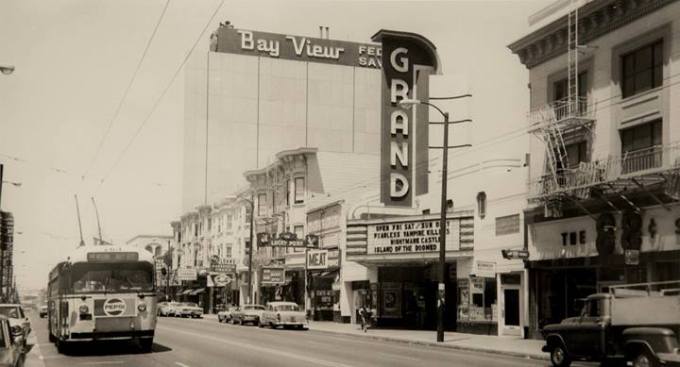
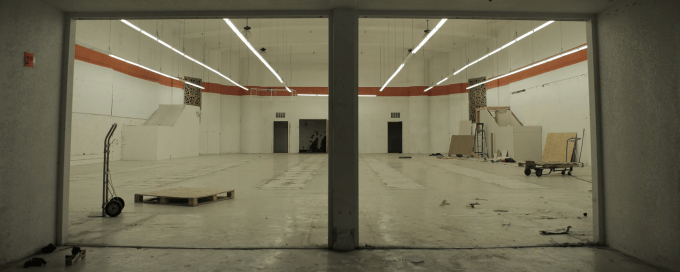
The Grand Theater (top) when it was a single-screen cinema in the heart of the Mission. The interior (below) as it looks today while undergoing renovations ahead of re-opening as a community arts space.
Now the non-profit is moving into the heart of the Mission. Its new abode is the old Grand Theater (pictured above), which has been a dollar store for the last decade or so. It was originally founded in the 1940s as an 870-seat single screen cinema.
In many ways, Melchor sits at the intersection of so much of what is changing about San Francisco today. She is a third-generation Mexican-American, who grew up in Coachella with a mother who sold tupperware door-to-door to make a living. Then while Gray Area arguably jumpstarted some of the gentrification happening in the Tenderloin, it was eventually priced out by the many tech companies that have moved there since.
“I started my first art gallery when I was 19,” she said. “I came from a low-income family and I was never really exposed to art until that age. I was so inspired by the first museum exhibit I ever saw that I used to my savings to create a space.”
Then, when she moved to San Francisco at 22, she wanted to do the same thing all over again.
“I was totally naive,” she said. “I quite literally went to grants office for arts at City Hall and asked how to get funding to start an art gallery. But they said, ‘We don’t know who you are. You’ve never done anything in San Francisco. Come back and knock on our door later.'”
So she started the foundation with money out of her own pocket, funding it through another job selling hardware. She gave it the name ‘Gray Area’ because she saw a need to bring the vastly different worlds of art, technology and community activism together.
“At the time I moved to San Francisco, I saw the Mission coming to life. I saw these two disparate communities that were not totally not engaged with each other. It wasn’t that they weren’t active or alive. They just needed this gray area, or this common ground.”
Moving Into The Tenderloin, And Then Getting Priced Out
It finally became a non-profit in 2008, and the city government asked Melchor to moved from the SOMA to the Tenderloin to help with reviving the mid-Market area, which is now the booming home to Twitter, Spotify, Zendesk and a number of other growth-stage companies.
The conditions of the new location weren’t the best. Occasionally, there would be water seeping through the roof.
But Gray Area grew in influence, giving shows to emerging artists like Aaron Koblin, who went on to be a creative director at Google and show work at New York’s MOMA after becoming famous for using mechanical turk and crowdsourcing to produce works like The Sheep Market.

Sheep Market, an early work from Aaron Koblin using mechanical turk. He had one of his first shows at Gray Area.
Melchor also threw the city’s first Urban Prototyping festival back in 2012, securing 68 pages of permits in the process. The idea was that cities were changing so rapidly that conventional planning processes were unable keep up, raising barriers for regular people to contribute to improving the physical fabric of the city itself.
So the festival was a way for citizens to come up with quick and inexpensive prototypes like parking space-sized pop-up stages for street performances.
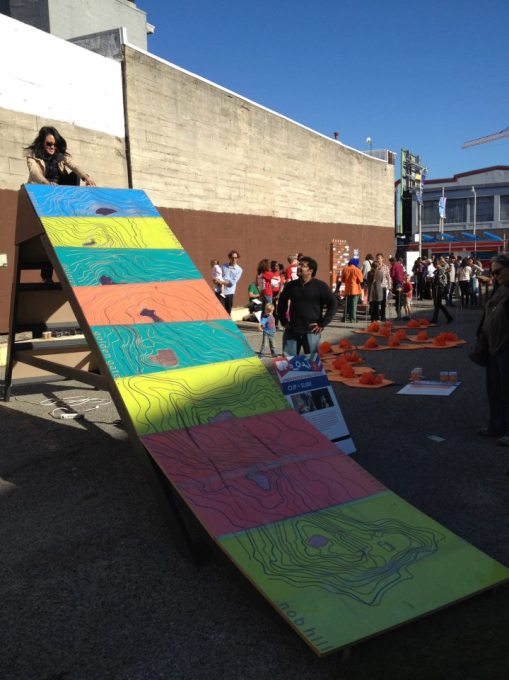
Tenderloin city supervisor Jane Kim rides down the “Clip and Slide” at the Urban Prototyping festival in 2012, which Gray Area presented.
Melchor pieced funding together for the non-profit through a few grants, education program revenue and sponsorships from companies like American Express and Adobe.
“We’ve never gotten a huge massive, million dollar grant or anything. It’s coming from different places,” Melchor said. “When I read TechCrunch, I get depressed seeing three students raising like $30 million when they don’t even have a prototype. We have a really hard time.”
Eventually, Gray Area had to move once more again away from Taylor Street. They moved into the old Warfield building on Market Street and had to invest roughly $60,000 to renovate the place. Before all the tech companies started to move in, they had a ton of space. Once they used every single floor of the building for a hackathon.
But then the neighborhood started to change with the Mid-market payroll tax break that the city offered to lure companies like Twitter and One Kings Lane into the area.
“We started to compete with tech companies, restaurants and developers,” she said. “They all wanted to wait until a startup showed up to pay more. We got a broker, but we were beat out multiple times by restaurants.”
It took a few years to find Gray Area’s newest space, the Grand Theater in the Mission. They looked around California and Polk, but local commercial broker Kalin Kelly eventually connected them with a space on Mission Street where the landlord fell in love with Melchor’s mission.
They’re in the process of renovating the space by ripping out the old fluorescent lighting and putting carpet back in the theater with about $300,000 in capital. They’re envisioning a performance space, incubator and co-working areas, along with rooms for after-school programs in art and technology for local high school students.
Gentrification’s Challenges For San Francisco’s Arts Scene
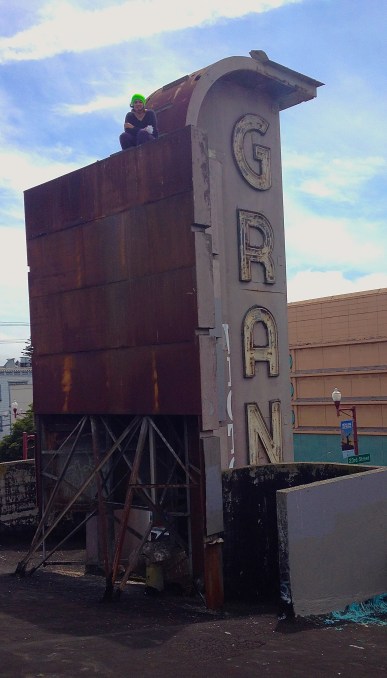
Melchor sits atop the Grand Theater’s sign on Mission Street as the whole venue undergoes renovations.
It isn’t always easy though being a new tenant in the neighborhood. As some say, Mission Street is the “last street standing” against a wave of gentrification that has irrevocably changed the largely Latino neighborhood over the last 15 years.
A proposed 351-unit housing complex at the corner of 16th street and Mission faces what could be the mother of all development battles as local residents are calling for higher allocations of affordable units and consideration for a neighboring school. At the other end of the Mission, local merchants just successfully pushed to get 24th street recognized as a historic district called Calle 24.
“People are really scared to see the dollar store go away and to see us standing in there. They think we’re gentrifying. But when we explain what we’re doing, they’re less afraid,” Melchor said. “When I was 19, I realized I had to bring art to the people. I had to bring people what I never had.”
At the same time, other city arts non-profits are struggling, like Intersection for the Arts, a 50-year-old alternative arts organization that has worked with actors and writers like Whoopi Goldberg, Ishmael Reed and Alice Walker. Similarly, some of the muralists behind the famed Clarion Alley project between Valencia and Mission St. have been evicted multiple times, while other working artists have decamped for the East Bay. In the face of skyrocketing rents, the city’s Board of Supervisors recently voted to allocate up to $4.5 million to help local non-profits keep up.
Then, while the tech industry has come to prize design more than it ever has before with the rise of companies like Nest, Jawbone and Apple, the local San Francisco tech community has yet to embrace or support the arts in the way that they are backed in the U.S.’s other creative capitals of Los Angeles and New York. There have been one-off commissions for decorating office space offered to artists like Ian Ross, who was an artist-in-residence at Facebook and now runs a gallery in SOMA.
But the broader San Francisco’s arts scene lacks the big institutions or commercial fairs like London and New York’s Frieze or Art Basel that provide grants, sales and financial opportunities for large numbers of working artists.
The scene is less commercial and more idiosyncratic and ephemeral with organizations like Burning Man, which becomes bigger and more costly every year, the many underground heirs to the old Cacophony Society, which bred writers like Fight Club’s Chuck Palahniuk, not to mention the community-oriented murals that adorn much of the Mission.
“There’s an underground element to San Francisco’s art scene. It’s not broadly celebrated and it doesn’t go across communities,” said Gray Area board member Peter Hirshberg, who was a longtime Apple executive. “We under-nurture emerging new media art too. It’s art that wants to be shown and played with.”
Plus, many of the industry’s younger companies like Twitter and Airbnb are only really beginning to figure out their community outreach strategies now.
“When the tech community says we should do better, it can ring hollow,” Hirshberg said. “There’s this old American notion of barn raising — that we’re building a house together. That kind of social capital only gets built when people from multiple communities actually spend time together.”